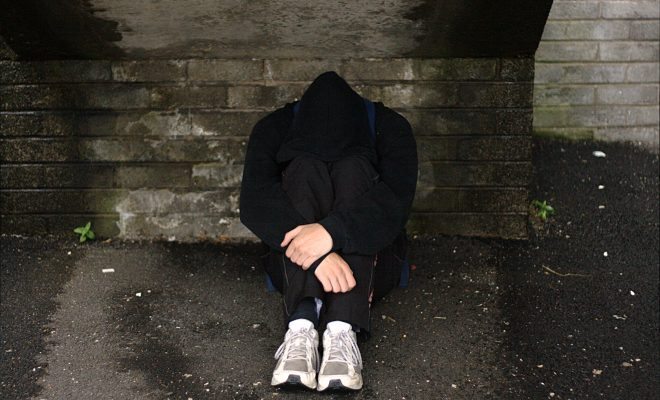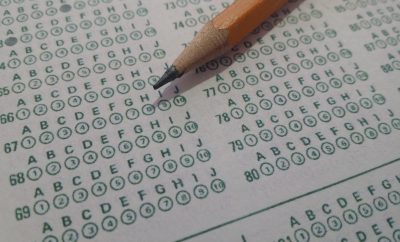
"Sad" courtesy of [John via Flickr]
Health & Science
Suicide Prevention Policies Aim to Curb Epidemic
Mental health and suicide prevention advocates are working to increase awareness of America’s suicide epidemic. In 2011, the most recent year for which there are relevant statistics, more than 39,000 Americans reportedly committed suicide. Suicide by veterans and members of the armed forces have been on the rise since 2001. Although safety nets and other deterrent mechanisms are used to discourage people from taking their lives, it has been proven that the first and most effective step to prevent suicide is recognizing and responding to the signs that signify someone is suffering from depression or mental illness. Advocates and mental health professionals emphasize recognition of trigger behaviors and attempt to provide better services to individuals struggling with depression and mental illness by working with federal, state, and local governments to provide access to essential services.
Click here to see some of the warning signs of suicide.
Here is everything you need to know about suicide: the causes, policies, and legislation that are used to curb the growing epidemic.
Who is at the highest risk of suicide?
Suicide used to be reported as predominantly affecting teens and much older people, yet according to The New York Times, “from 1999 to 2010, the suicide rate among Americans ages 35 to 64 rose by nearly 30 percent.” Click here to see the most at-risk populations. Suicide also tends to be brought on by life trauma, such as abuse or childhood neglect. People who suffer from depression, mental illness, eating disorders, or have a history of drug use also have an increased chance of suicide.
Suicide Prevention Policies and Legislation
Case Study: Duke Ellington and Taft Bridges in Washington, DC
Similar to the Golden Gate Bridge, the Duke Ellington Bridge in Northwest Washington, DC is an infamous location for suicides. On average about four suicides a year occur on the bridge, and in 1985, three people jumped off of it within a 10-day period. The busy Rock Creek Park below is a daunting 125-foot plunge. Half of all suicides in the District of Columbia occur on this notorious bridge.
In 1987, the National Trust for Historic Preservation brought a lawsuit against the efforts to build a suicide barrier at the Duke Ellington bridge. The organization claimed that the project was not protected by the Department of Transportation Act and that ultimately the erection of a barrier would ruin the historical and aesthetic appeal of the well-known bridge. The Trust also argued that the barrier served no purpose as people intent on committing suicide would simply migrate to the nearby Taft Bridge. In 1990, Congress vetoed the case to remove the barriers, and they still remain in tact today. A study conducted five years after the barrier construction showed that there were no suicides committed from the Duke Ellington bridge, and the count on the Taft Bridge remained virtually unchanged. In this case, the suicide barrier seems to be effective in the nation’s capital, once again proving suicide to be impulsive in nature.

Duke Ellington Bridge in Washington D.C. [Michiel 1972 via Wikipedia]

Suicide Barrier on the Duke Ellington Bridge [Alyson Hurt via Flickr]
Bullying and Suicide
Case Study: Rebecca Ann Sedwick
In September 2013, Florida resident Rebecca Ann Sedwick committed suicide after being repeatedly bullied throughout her time at Crystal Lake Middle School. Sedwick’s mother, Tricia Norman, pulled her from the school after Sedwick had been attacked by a group of peers. Norman also discovered harassing text messages on her daughter’s phone, and even more shockingly Sedwick had self-inflicted cuts up and down her legs.
After Norman became aware of her daughter’s torment, she moved her to Lawton Chiles Middle Academy to attend the seventh grade. Despite the change in schools, the bullying continued. Most of it came from social media websites such as Kik Messenger, Instagram, and Ask.fm, all of which can be used anonymously. Some of these messages included: “You should die” and “why don’t you go kill yourself?”
Twelve-year-old Katelyn Roman and 14-year-old Guadalupe Shaw were charged with aggravated stalking and arrested as juveniles. Just one month later, the charges were dropped, and the war between Norman and the authorities began. According to CNN, Norman’s attorney said in a statement that he plans to sue both the Polk County School Board and one or both of the girls who were arrested in the case.
Bullying: Social Media
The main reason that the charges against Roman and Shaw were dropped is because of the lack of available evidence. Many of the sites that Sedwick was bullied on were “disappearing apps,” meaning that the messages would automatically be deleted after a short period of time. In an attempt to gain justice for Sedwick and prevent future online bullying cases from going unidentified, Norman continues to work to develop a safer social media environment. Recently one the websites that Sedwick used, Ask.fm, added a “Safety Tools” page that details its anti-bully safety features.
Click here to read more about bullying and social media.
Rebecca’s Law
In response to Sedwick’s suicide as a result of bulling, Florida is considering Rebecca’s Law, which would punish bullying as a misdemeanor and aggravated bullying as a third-degree felony. In Florida where Sedwick was a resident, there is no legislation that can punish an individual legally solely based on the loosely defined term “bullying.” If the bill passes, alleged bullies could face fines or in more severe consequences jail time.
This is not the only case that has resulted in the suicide of a school-aged child or teen. In response to the tragedy, the Safe Schools Improvement Act of 2013 was proposed to crack down on bullying in schools. Its main purpose is to outline anti-bullying policies, which include creating a comfortable and safe environment at school for every child. The bill calls for the state to submit an annual report evaluating the programs being used to end bullying in secondary and elementary schools. The bill calls for evaluation of training programs for professionals, as well as a survey of parent involvement.
Case Study: Grace’s Law
Fifteen-year-old Grace McComas of Howard County, Maryland committed suicide on Easter Sunday 2012. Similar to Sedwick, McComas was repeatedly harassed on online social media sites, which ultimately drove her to suicide.
In response to the death of McComas, Grace’s Law was passed in 2013 to end cyber bullying through the banning and regulation of electronic harassment. The law prohibits “a person from using a computer or computer network to disseminate certain data with the malicious intent to psychologically torment or harass a minor.” Anyone who chooses to violate this and bully someone under the age of 18 could be punished with a misdemeanor charge.
Suicide on College Campuses
Suicide at Universities
College is a stressful time for many students; they are in a new environment, have to make new friends, and are under the pressure of maintaining both good grades and the responsibility of extracurricular activity. College can be a balancing act, and often stress, depression, and loneliness can affect and overwhelm students. In extreme cases they resort to what they feel to be the last option, suicide. According to the National Alliance on Mental Illness, “Suicide is the third leading cause of death on college campuses” and the Jed Foundation reports that, “half of all college students have had suicidal thoughts.”
Not only does suicide affect the friends and family members if the deceased, it also puts universities at risk for lawsuit.
University Responsibility
Many schools adhere to the No-Duty-to-Prevent-Suicide rule; however, there have been cases in which families of students who committed suicide sue the school based on its mental health policy. One such case, Eisel v. Board of Education of Montgomery County occurred in Maryland. The parents of Nicole Eisel sued the School Board for the middle-school counselor’s failure to report Eisel’s expression of suicidal preoccupation. This case set a standard for both counselors and schools: “School counselors have a duty to use reasonable means to attempt to prevent a suicide when they are placed on notice of a student’s suicidal intent.” A school will not necessarily be convicted in the case of a student suicide, yet if the student expresses obvious signs and the school fails to intervene, it may be held liable. In contrasting cases such as White v. University of Wyoming, Jain v. State, and Bogust v. Iverson, the No-Duty-to-Prevent-Suicide rule held and the schools were ultimately exempt from accountability for student suicides.
Organizations to Prevent Suicide at Universities
The most recognized organization in suicide reform is the organization started by Alison Malmon, Active Minds. It was founded in Washington DC in 2003, three years after Malmon’s brother committed suicide due to mental health issues. Active Mind’s main mission is to eliminate the stigma associated with mental illness and urge students to seek help.
One parent, whose college-aged son committed suicide created the Jason Foundation, which works to prevent youth suicide through awareness and education. The organization is working to create a smartphone app that will connect people contemplating suicide directly to a hotline to receive support and immediate intervention.
There are also organizations such as the Jed Foundation that focus on student mental health and work to end suicide in the college population through campus counseling and programs. The Jed Foundation is fighting to have congress include a mental health screening within its health reform bills.
The National Alliance on Mental Illness offers several education and support services for mental health crises, as well as support the battle to end suicide on campuses.
The Campus Suicide Prevention Grants program targets students with mental illness and substance abuse issues. It aims to improve services and expand access to services for students who are at a higher risk of suicide. Both private and public institutions of higher learning can apply for the grant
Suicide Prevention: National Innovation
Surgeon General Regina Benjamin is a strong backer of the national initiative to decrease suicide in the United States. A National Strategy containing four main pillars has been proposed:
- Direct a focus to the family, the individual, and the community.
- Develop better preventative techniques.
- Provide efficient and easily accessible treatment for mental health.
- Improve the surveillance of data and enact appropriate and timely methods based on the analysis.
Medicaid has already started to cover depression screenings. According to USA TODAY, “physicians will be rewarded by Medicare and Medicaid for screening depressed patients for suicide risk.” This is an incentive for doctors to follow through with care, and highlights the importance of mental healthcare.
Two bills currently being considered by the House of Representatives are aimed at mental healthcare improvements. HR 3717, the “Helping Families in Mental Health Crisis Act,” covers psychiatric support for families and patients that have the most crucial needs. HR 4574, the “Strengthening Mental Health in our Communities Act of 2014″ includes offering more community-based services accessible to individuals with mental health needs. Organizations such as The National Alliance on Mental Illness, are strong supports of this legislation and are petitioning to have it enacted into law.
Suicide Prevention: State Level
Case Study: The Matt Adler Suicide Assessment, Treatment, and Management Act of 2012
Lawyer Matt Adler committed suicide in February 2011 due to extreme depression and anxiety. In response to her husband’s death, Adler’s wife Jennifer Stuber worked with the state of Washington to take legislative action to prevent future suicides. One year later in March 2012, the Matt Adler Suicide Assessment, Treatment, and Management Act was signed into law. The Act requires “mental health professionals, social workers, and occupational therapists to receive six hours of training every six years, as part of their continuing education requirement.“ This mandatory training ensures that professionals are better equipped to identify and handle signs of suicide.
Click here to see Washington State Bill that requires mandatory training for clinical professionals on suicide prevention.
Almost every state has a plan to prevent suicide, including similar tactics to combat the issue, such as education, suicide-awareness initiatives, survey and analysis of statistical evidence, and improvement of medical and support services are all strategies to fight the epidemic. To see a few of these suicide prevention plans, click on the state link: Colorado , Indiana, Wisconsin, New Hampshire, California, Texas, and Idaho.
Methods of Action
Zero Suicide Academy
Although suicide barriers and hotline support can stop the act of suicide, they do not address the underlying issues at hand — the victim’s mental health. Even if someone is deterred from suicide once, it does not guarantee that the thoughts will be permanently eliminated. People who contemplate suicide tend to have a suicidal tendency based on mental or environmental causes.
In response to the nationwide epidemic, the Alliance for Suicide Prevention held a conference in Washington, DC in June 2014. Participants discussed several methods of identifying risk factors and methods of action to reduce suicide rates. The discussion revolved around the “Zero Suicide Toolkit” that includes six components:
1. Creating the Zero Suicide Culture. This consists of creating efficient and reliable care for people at risk, while also ensuring that the clinicians themselves receive care and compassion in order to maintain a healthy and effective environment for both the patient and the professional.
2. Ensuring Every Person Has a Pathway to Care is an important element in identifying suicidal behaviors and preventing the patient taking action based on their specific risk level and needs. Follow-up care is also an important component in ensuring every patient receives the most effective care.
3. Developing a Competent Workforce is key to keeping employees mentally healthy. This consists of developing a system where there is “collaboration, team approaches, and effective communication” in place. Employees and behavioral health staff should be aware of suicidal signs and react in a supportive manner. The behavioral staff, should be trained and able to provide the mental health needs of staff at risk.
4. Identifying and Assessing Suicide Risk Level is important in understanding each individual’s specific situation and reacting based on a plan tailored to that person’s specialized treatment needs.
5. Using Effective, Evidence-based Care focuses on keeping the individual out of a hospital setting if possible. This consists of collaborative therapy with a focus on behavioral and problem-solving strategies.
6. Continuing contact after care is a vital component in ensuring that the patient will remain healthy. Follow-up services and support groups are a key element in maintaining an individual’s well being after initial care.
Click here to see the conference framework in its entirety.
Conclusion
There is progress being made toward slowing the suicide epidemic in this country, including action at the local, state, and federal levels to decrease the rate of suicide. Education, awareness, and supportive services for families, communities, and mental health professionals are all part of broad framework to combat suicide. Suicide is a mental health issue with subjective impulses, so it is to completely eliminate, yet as a society we have started to recognize the signs and are taking policy and legislative action to combat this epidemic.
Resources
Healthy Children: Help Stop Teen Suicide
American Foundation for Suicide Prevention: Preventing Suicide
UCLA Center: School Interventions to Prevent Youth Suicide
ABC: Mom of Suicide Tween Rebecca Sedwick to Sue ‘Those Responsible’
Crimesider: “Rebecca’s Law” aims to punish bullying in Fla.
SPRC: Success and Inspiration at the Zero Suicide Academy
The New York Times: The Urge to end it all
Action Alliance: Zero Suicide in Health and Behavioral Health Care
USA Today: Surgeon General Urges new Focus on Suicide Prevention
USA Today: Suicide Prevention the Focus of new Government , Campus Programs
Huffington Post: How to Prevent Your Ivy League Student From Becoming Suicidal
USA Today: Recent has University Reflecting on College Stress
CNN: Police file raises questions about bullying in Rebecca Sedwick’s suicide
Baltimore Sun: Grace’s Law, a cyberbullying bill, called ‘landmark legislation’
UNC Law: Student Suicides and School System Liability
Ledger: Lakeland Girl Commits Suicide After 1½ Years of Being Bullied
CNN: Sheriff: Taunting post leads to arrests in Rebecca Sedwick bullying death
USA Today: Surgeon General Urges New Focus Prevention on Suicide Prevention








Comments